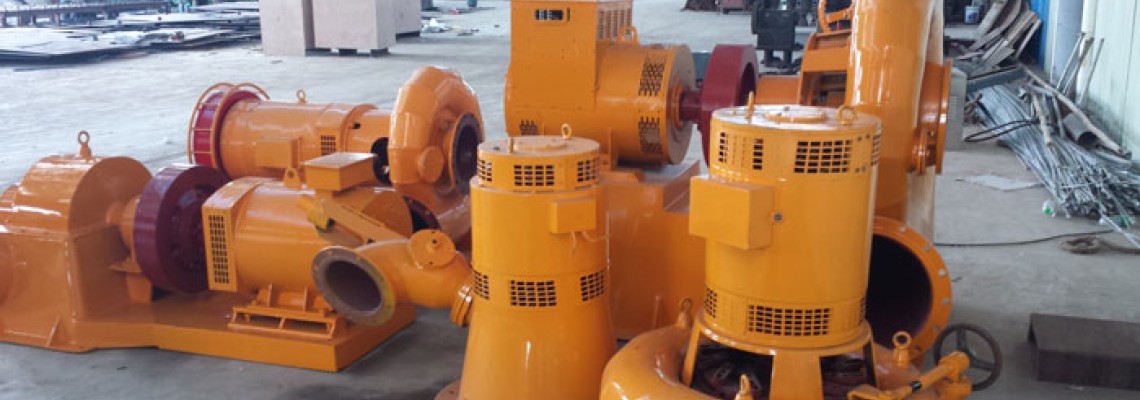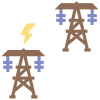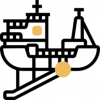
The Francis Hydro Turbine Generator is a type of water turbine. It is an inward-flow reaction turbine that combines the concepts of radial and axial flow. The Francis Hydro Turbine Generator is one of the most commonly used turbines today, with efficiencies exceeding 95%.
The design process for modern Francis turbines spanned from 1848 until around 1920. Around 1920, this turbine became known as the Francis Hydro Turbine Generator, named after the American engineer James B. Francis, who created a new turbine design in 1848.
The Francis Hydro Turbine Generator is primarily used for electricity generation. The power output of generators typically ranges from a few kilowatts to 1000 megawatts, though small hydroelectric installations may have lower power. Performance is optimal when the head height is between 100 and 300 meters (330 to 980 feet). The diameter of the pressure pipe ranges from 1 to 10 meters (3.3 to 32.8 feet). The rotational speed of different turbine units ranges from 70 to 1000 revolutions per minute. The guide vanes on the outside of the rotating runner control the flow rate through the turbine to achieve various power outputs. The Francis Hydro Turbine Generator is usually installed with a vertical axis to separate the water from the generator, which also facilitates installation and maintenance.
The main components of the Francis Hydro Turbine Generator are:
-
Spiral Casing: The spiral casing around the turbine runner is also called the volute or spiral casing. The entire length of the volute has many evenly spaced openings to allow the working fluid to impact the runner blades. These openings convert the pressure energy of the fluid into kinetic energy before it impacts the blades. Despite providing many openings for the fluid to enter the blades, the cross-sectional area of the casing decreases uniformly around the circumference to maintain a constant velocity.
-
Guide Vanes and Fixed Blades: The main function of the guide vanes and fixed blades is to convert the pressure energy of the fluid into kinetic energy. They also direct the fluid at the designed angle to the runner blades.
-
Draft Tube: The draft tube is the conduit connecting the runner outlet to the tailrace, where water exits the turbine. Its main function is to reduce the velocity of the exiting water flow to minimize kinetic energy loss at the outlet. This allows the turbine to be placed above the tailrace, without significantly reducing the available head.
The Francis turbine is a reaction turbine, where the working fluid enters the turbine under high pressure, and the turbine blades extract energy from the fluid. Part of the energy is released by the fluid, as the pressure changes on the turbine blades can be quantified by the reaction degree, while the remaining energy is extracted by the turbine’s volute. At the outlet, water impacts the rotating cup-shaped runner and exits at low speed and low swirl, leaving very little residual kinetic or potential energy. The shape of the turbine outlet pipe helps to decelerate the water flow and restore pressure.
Francis Hydro Turbine Generator Factory in China: Professional Overview
At our Francis Hydro Turbine Generator factory in China, we pride ourselves on producing high-quality, efficient turbines that meet customer needs. Our facility is equipped with state-of-the-art technology and machinery, allowing us to manufacture reliable and durable turbines.
Our team of experienced engineers and technicians works diligently to ensure that every turbine leaving our factory meets our strict quality standards. We use only the finest materials and components to ensure our turbines are not only efficient but also durable, able to withstand high-intensity usage demands.
When you choose a Francis Hydro Turbine Generator from our factory in China, you can be confident that you are receiving a product designed and manufactured to the highest standards. Whether you need a turbine for a hydroelectric power plant or other industrial applications, we have the expertise and experience to provide a product that meets your needs.
CN Electric Francis Hydro Turbine Generator Overview
At our factory in China, we specialize in producing Francis Hydro Turbine Generators. These generators are widely used in hydroelectric power plants and are known for their high efficiency and reliability.
The Francis Hydro Turbine Generator is a hydraulic turbine that converts the energy of flowing water into electrical energy. It consists of a turbine wheel, runner, and generator. The turbine wheel is driven by hydraulic force, causing the runner to rotate. The generator then converts the mechanical energy of the runner into electrical energy.
Our Francis Hydro Turbine Generators are designed to meet the specific needs of our customers. We offer a range of models with different power outputs, from a few kilowatts to several megawatts. Our generators are also designed to operate under various water pressures and flow rates, making them suitable for a variety of hydroelectric power plants.
In addition to high efficiency and reliability, our Francis Hydro Turbine Generators are also designed for ease of installation and maintenance. We use high-quality materials and advanced manufacturing techniques to ensure our generators are durable and long-lasting.
Overall, our CN Electric Francis Hydro Turbine Generators are an excellent choice for hydroelectric power plants seeking reliable and efficient power sources. With our years of experience and expertise, we are confident in our ability to provide the best solutions to meet our customers' power generation needs.
China's Role in Francis Hydro Turbine Generator Production
China has become a major player in the production of Francis Hydro Turbine Generators. Our research shows that China is now the world's largest producer of Francis Hydro Turbine Generators. We have identified several factors contributing to China’s success in this field.
Firstly, China has invested heavily in manufacturing development. This investment has enabled Chinese companies to produce high-quality products at lower costs than competitors. Additionally, the Chinese government supports the industry through subsidies and other incentives.
Secondly, China has a large pool of technical workers. The country’s education system produces a significant number of graduates in engineering and other technical fields. This has enabled Chinese companies to develop and manufacture complex machinery like the Francis Hydro Turbine Generator.
Thirdly, there is strong domestic demand for Francis Hydro Turbine Generators in China. The country is rapidly developing its infrastructure and requires substantial amounts of electricity. This has created strong demand for Francis Hydro Turbine Generators, which Chinese companies have been able to meet.
Finally, Chinese companies have successfully expanded their business beyond the domestic market. They have successfully exported Francis Hydro Turbine Generators to other countries, particularly in Asia and Africa. This has helped increase China’s share in the global market.
In summary, China's success in Hydro Turbine Generator production can be attributed to several factors, including government support, skilled labor, a large domestic market, and successful export strategies. As a result, China has become a key player in the industry, and its importance is likely to continue growing in the coming years.
Manufacturing Process for Francis Hydro Turbine Generators
At our factory in China, we follow a strict manufacturing process to ensure the highest quality of Francis Hydro Turbine Generators. Our manufacturing process includes the following steps:
Step 1: Casting
We start by casting the turbine runner, guide vanes, and other components using high-quality stainless steel. The casting process is done with precision molds to ensure each component has the exact shape and dimensions.
Step 2: Machining
Once casting is complete, we proceed with machining the components to achieve the final shape and dimensions. This step involves using CNC machines to achieve precise tolerances and smooth surfaces.
Step 3: Assembly
After machining, we assemble the components to form the Francis Hydro Turbine Generator. This step includes mounting the turbine runner on the shaft, installing the guide vanes, and fitting the bearings and other components.
Step 4: Testing
Before shipping the Francis Hydro Turbine Generator to customers, we conduct rigorous testing to ensure it meets all performance specifications. This includes testing efficiency, power output, and other key parameters.
Overall, our manufacturing process ensures that our Francis Hydro Turbine Generators are of the highest quality and reliability. We take pride in our work and strive to provide the best products to our customers.
Quality Control at Our Francis Hydro Turbine Generator Manufacturing Facility in China
At our Francis Hydro Turbine Generator factory in China, we take pride in our commitment to quality control. We understand that customers rely on our products to provide reliable and efficient power generation, and we take this responsibility seriously.
To ensure the highest quality, we implement stringent quality control processes, including multiple inspections and checks throughout the manufacturing process. Our quality control team consists of experienced engineers and technicians who are dedicated to ensuring each component meets our rigorous standards.
One key aspect of our quality control process is the use of advanced testing equipment. We utilize a range of tools and techniques to test each component, including ultrasonic testing, X-ray testing, and magnetic particle testing. These tests allow us to identify any potential defects or flaws in materials or components before they become issues.
In addition to testing equipment, we have a comprehensive documentation system. Every component is carefully tracked and documented throughout the manufacturing process, from initial design to final assembly. This allows us to quickly identify any issues that may arise and take corrective actions as needed.
Overall, our commitment to quality control is a key factor in our success as a Francis Hydro Turbine Generator manufacturer in China. We believe that by maintaining the highest quality standards, we can continue to build strong relationships with our customers and provide them with the reliable power generation solutions they need.
Export and Import Policies
At our Francis Hydro Turbine Generator factory in China, we are committed to complying with all relevant export and import policies. Our team is dedicated to ensuring that our products meet all necessary regulations and standards and are shipped safely and efficiently to customers around the world.
When exporting Francis Hydro Turbine Generators, we work closely with shipping partners to ensure that all required documentation and permits are in place. We provide detailed information about our products, including technical specifications, shipping dimensions, and weights, to help our customers plan and prepare for their orders.
Regarding import policies, we continuously monitor changes and updates in regulations across different countries to ensure we comply with all requirements. We work with customers to provide any necessary documentation or certificates to facilitate the import process and strive to make the process as smooth and straightforward as possible.
We understand that navigating export and import policies can be complex and challenging, but our team is here to assist you. We are committed to providing the highest level of service and support to our customers and will do our utmost to ensure that their experience with us is positive and successful.
Future Trends in Francis Hydro Turbine Generator Manufacturing in China
Technological Advancements
We anticipate significant technological advancements in Francis Hydro Turbine Generators in China in the future. As the demand for clean energy continues to grow, there is an increasing need for more efficient and reliable turbines. Manufacturers are investing heavily in research and development to enhance the efficiency and performance of Francis turbines.
One area of focus for technological advancements is the materials used in turbine manufacturing. We expect an increased use of high-strength materials, such as composites, to improve the durability and reliability of turbines. Additionally, advancements in digital control systems and sensors will enable more precise control of turbines, further enhancing efficiency.








